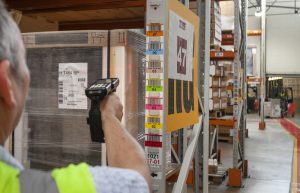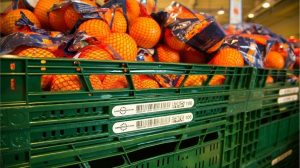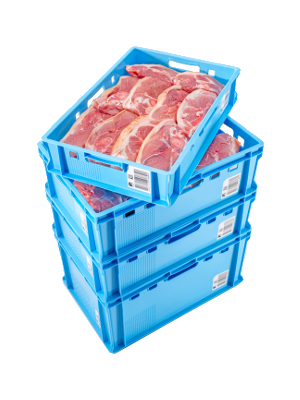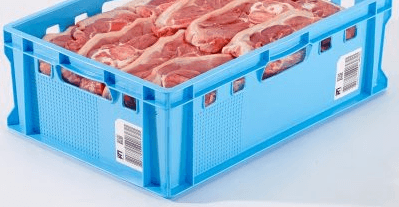In the UK the food industry is governed by strict regulations to ensure that the products we eat are protected and kept safe. This means that standards of hygiene and sanitation are equally important in every area of the food processing chain to maintain the quality and nutritional value of food.
Before it reaches the retail shelves, much of our food spends a period of time in storage within warehouses or distribution centres. To enable warehouse staff to find the right stock quickly and easily, food products need to be clearly identified at each stage of the storage process. This blog is a guide to effective warehouse labelling in the food industry.
Why do we need food warehouse labels?
When food products are initially received into the warehouse, they are identified and placed into storage. Once an order is received, the product is retrieved from its location, sorted, packaged, checked and then distributed from the storage facility.
The product itself must be clearly labelled so that the food item is simple to track through the supply chain.
The storage area needs to be labelled so that warehouse operatives can navigate their way through the warehouse and find the right product quickly and easily, increasing productivity. It also helps a business to keep better track of its inventory levels, reducing the risk of over or understocking to improve order fulfilment.
Where can labels be located in the food warehouse?
Floor labels – for highly stacked bulk locations, floor barcode labels are convenient to scan. They need to be extremely durable to withstand fork lift truck traffic and high pressure cleaning with detergents.
Racking labels – one of the most common types of warehouse labels, these labels are located at eye level to either uprights or cross beams for ease of scanning.

Shelf labels – available as magnetic, retro-reflective or durable laminate options, these labels need to be compatible with pick by voice systems.
Pallet/Tote/crate labels – available as either adhesive labels for plastic, metal or wood, or alternatively as in-mould labels (a method of directly incorporating labels into injection-moulded products).
Different types of food warehouses
Depending on the particular kind of food product to be stored there are three different types of warehouse options, frozen, chilled or dry storage.
Frozen storage – keeps products at a minimum temperature of O° F
Chilled storage – keeps products at a refrigerated temperature between 34 to 39 ° F
Dry storage – refers to storing food products that do not require a controlled temperature and are usually stored between 50 and 70° F
The variety of temperatures required to store food safely means that different types of warehouse labelling are required to perform effectively within the specific temperature ranges.
What are the different types of labels for a food warehouse?
Adhesive labels – placed on the surface of a container and made using the latest print technology, permanent under-surface printing means that adhesive labels are now scratch proof and wash resistant. As these labels are durable, data can continue to be read accurately and clearly over time.
In-mould labels – these labels are bonded into the plastic container during manufacture. No adhesive is used and the result is a permanent and edgeless bond between the label and the container. This makes in-mould labels ideal for the food industry as the risk of any contamination behind the label is completely eliminated.

Magnetic labels – magnets are available in a variety of materials and thicknesses. Using magnets to attach labels to racks or shelves fixes them without the need for adhesive. As a result there is no residue, they can be moved easily and re-used.
Cold storage labels for the food warehouse
Highly visible labels and signage within cold storage areas are important to give operatives working within them the best chance of reading the label or barcode at speed. This means they can retrieve items quickly and safely, seconds count when working in a freezing warehouse.
Cold storage is a particularly tough environment for traditional barcode tracking systems. By using strong adhesives for labels and constructing them from special materials that can resist damage in freezing conditions prevents many of the traditional cold storage label problems of cracking and curling. Advanced technology has resulted in barcoding applications that can be used at sub-zero temperatures down to -40° C.
RFID labels are both heat and cold resistant making them ideal for use in freezing or refrigerated situations.
Industrial strength magnets are also particularly suited to labelling in cold temperatures – these are available in ceramic options.
Why are barcode labels important in food logistics?
Barcodes are important in food logistics because all of the information regarding the product is stored on the barcode label, including where the product is located. This eliminates writing or transcription errors and, providing the barcode is of sufficient quality, is an extremely accurate method of labelling food products.
The barcode also allows real time tracking of a product, this is particularly important in food logistics where many products are date-sensitive.
The barcode label serves as a critical link between a company’s warehouse management system (WMS) and the employees picking the products. This makes the quality of the barcode on the label a crucial element in the smooth running of a food warehouse.
How to choose the best labels for your food warehouse
Quality labels are both durable and accurate
Investing in quality labels is a sure way to save money in the long run. They will be more durable so will last longer, they will continue to scan accurately over time and will be far less prone to wear and tear.
Check labels are easy to locate and scan
Make it easy for warehouse operatives to locate products by using clear labelling which they can find quickly and read/scan without difficulty.
Always pay attention to scan distances – place labels in optimum positions for the scanning system used.
Colour coded labels can improve efficiency
Using colour coded labels can help to differentiate food zones within a warehouse environment. This is particularly important in a food warehouse to prevent cross-contamination of food products.
Labels that can withstand cleaning and sanitising
As hygiene in food warehouses is of paramount importance, equipment has to be cleaned and sanitised on a regular basis. Therefore it is essential that labels on food containers, for example meat crates, can withstand high temperatures and chemical wash processes.

A look into the future of food labelling
With climate change issues high on the global agenda highlighting the importance of recycling and producing less waste, re-useable plastic trays for the food industry are gaining momentum rapidly.
Projects such as Vytal’s reusable packaging system are already popular for short shelf-life products in Ireland and across Europe. These plastic trays feature RFID in-mould labels from inotec that are wash-proof and hygienic with no adhesive label edges for bacteria to collect, making them an ideal choice for the food industry.
Choose warehouse labels from a leading supplier
Engineering a wide range of labels for some of the world’s leading companies, inotec specialises in providing labels for a variety of food storage environments from ambient warehouses to freezing cold stores.
The company supplies durable barcode labels, in-mould labels, RFID solutions as well as comprehensive floor and overhead warehouse signage.

